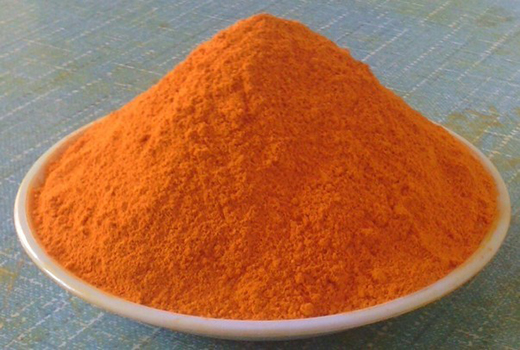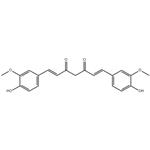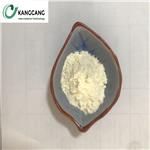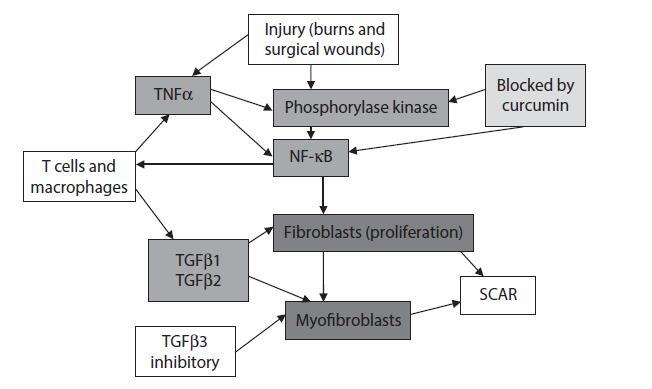The role of curcumin in food additives and preservatives
Introduction
Curcumin is a natural compound with good anti-inflammatory and anticancer properties[1]. Curcumin is a diketone compound extracted from the rhizomes of some plants in the Zingiberaceae and Araceae. The chemical formula is C21H20O6. Among them, turmeric contains about 3% to 6% of curcumin, which is a very rare pigment with diketone structure in the plant kingdom. Curcumin is an orange-yellow crystalline powder with a slightly bitter taste and is insoluble in water. It is mainly used in food production to color sausage products, canned food, and soy sauce products. Curcumin has the functions of lowering blood lipids, anti-tumor, anti-inflammatory, choleretic, and antioxidant. In addition, some scientists have found that curcumin can help treat drug-resistant tuberculosis.

Picture 1 Curcumin powders
The development of curcumin
Curcumin was first isolated as a low molecular weight polyphenolic compound from Curcumalonga L. in 1870, and its chemical structure of bis-feruloylmethane was elucidated in 1910, followed by studies on its physiological and pharmacological effects[2]. Significant progress has been made. With the deepening of research on curcumin, it has been found that it has a wide range of pharmacological activities such as anti-inflammatory, anti-oxidation, lipid-regulating, anti-viral, anti-infection, anti-tumor, anti-coagulation, anti-hepatic fibrosis, and anti-atherosclerosis. , and low toxicity and adverse reactions. Curcumin is currently one of the largest natural food colorings in the world, and is a food additive approved by the World Health Organization, the U.S. Food and Drug Administration and many countries. Researchers are not only attracted to curcumin as a non-steroidal anti-inflammatory drug, but because of its chemopreventive properties, curcumin has broad preventive properties against disease. In view of the fact that modern medical research has found that the occurrence of many diseases in the human body is related to the formation of free radicals and the participation of inflammatory reactions, the antioxidant activity and anti-inflammatory effects of curcumin have attracted extensive attention from scholars at home and abroad.
The sources of curcumin
The main sources of curcumin are turmeric root, turmeric rhizome, curcuma rhizome, and calamus rhizome of Araceae. Curcumin is orange-yellow crystalline powder, slightly bitter in taste, insoluble in water and ether, soluble in ethanol and propylene glycol, easily soluble in glacial acetic acid and alkaline solution, reddish-brown when alkaline, and yellow when neutral and acidic. Curcumin has strong stability to reducing agents and strong coloring properties. It is not easy to fade after coloring, but it is sensitive to light, heat and iron ions, and has poor light resistance, heat resistance and iron ion resistance. Since there are two hydroxyl groups at both ends of the curcumin molecule, the conjugation effect of electron cloud deviation occurs under alkaline conditions, so when the pH is greater than 8, curcumin will turn from yellow to red. Modern chemistry takes advantage of this property as an acid-base indicator.
The role of curcumin in food additives
Curcumin has been widely used in the food industry as a common natural pigment for a long time. It is mainly used for the dyeing of canned food, sausage products and soy sauce products. The amount of curcumin used is determined by normal production needs. The product form of functional food with curcumin as the main component can be general food or some non-food forms, such as capsules, pills or tablets. For general food form, some yellow pigmented foods can be considered, such as cakes, sweets, beverages, etc.
Curcumin is a food additive approved by the Codex Alimentarius Commission of the Food and Agriculture Organization of the United Nations (FAO/WHO-1995). The newly promulgated "Standards for the Use of Food Additives" (GB2760-2011) stipulates that frozen drinks, cocoa products, chocolate and chocolate products and candies, gum-based candies, decorative candies, toppings and sweet sauces, batter, coating powder and frying powder , The maximum usage of curcumin in instant rice and noodle products, flavored syrup, compound seasoning, carbonated drinks and jelly is 0.15, 0.01, 0.7, 0.5, 0.3, 0.5, 0.5, 0.1, 0.01, 0.01 g/kg, respectively, margarine and its similar products, cooked nuts and seeds, fillings for grain products and puffed foods can be used in moderation according to production needs.
The role of curcumin in preservatives
At present, curcumin is widely used in the food industry as a condiment and a pigment at home and abroad. In medieval Europe, turmeric can replace the precious spice saffron, and it is also an indispensable traditional curry food in Indian life, a common condiment in kebabs in the Middle East, a common condiment in Persian and Thai dishes, and a common coloring in mustard sauce. Curcumin used for food coloring is mainly divided into four categories: water-dispersible turmeric oil, water-dispersible purified turmeric, oil-soluble purified curcumin and purified turmeric powder. my country began to research and apply curcumin in the mid-to-late 1980s, and reached its peak in the early 1990s, but due to product quality, the degree of marketization is not high. At present, water-soluble and oil-soluble curcumin products comparable to foreign countries have been developed in China, and curcumin of various shades has been produced through compounding, which has been widely used in pasta, beverages, fruit wine, candy, cakes, canned food, juice and Cooking dishes, used as compound seasonings in chicken essence compound seasonings, puffed seasonings, instant noodles and noodle puffed products, instant food seasonings, hot pot seasoning sauces, paste flavors and fragrances, seasoning pickles, beef jerky products, etc. my country is one of the main producing areas of turmeric in the world, and it is rich in resources. At present, the annual output has reached tens of thousands of tons, and it has a good market advantage.
Reference
1 Lestari M L A D, Indrayanto G. Curcumin[J]. Profiles of drug substances, excipients and related methodology, 2014, 39: 113-204.
2 Sharma R A, Gescher A J, Steward W P. Curcumin: the story so far[J]. European journal of cancer, 2005, 41(13): 1955-1968.
);You may like
Related articles And Qustion
See also
Lastest Price from Curcumin manufacturers

US $10.00-3.00/KG2024-04-27
- CAS:
- 458-37-7
- Min. Order:
- 1KG
- Purity:
- 99%
- Supply Ability:
- g-kg-tons, free sample is available

US $9.00-70.00/g2024-04-26
- CAS:
- 458-37-7
- Min. Order:
- 10g
- Purity:
- 99%
- Supply Ability:
- 10 tons




